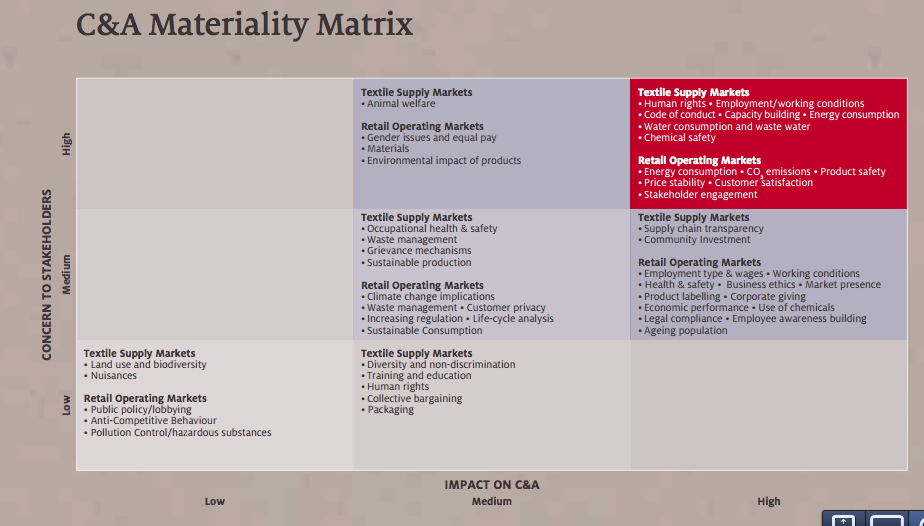This series of posts aims at showing how fashion companies are changing the way they conduct business to make it a better business. We will look at the achievements of these businesses in terms of innovation and sustainability and, possibly, how these achievements affect their business.
C&A, part of the Cofra Holding that owns C&A Europe, Brazil, Mexico and China, has been a family business since 1841.
The company is quite conservative in communicating corporate responsibility achievements. Their style of communication appears to be more emotional than factual.
The company has been awarded the Textile Exchange Future Shaper award in 2012 recognising the company’s commitment to promoting the analysis and certification of organic cotton and textiles. C&A is also a founding member of Textile Exchange.

C&A has a EU Crisis Management Team made of experts of CR, law and corporate communications reporting to the CEO. A milestone to their sustainability journey was the establishment of an Environmental Working Group in 1989.
What is considered a priority sustainability issue at C&A largely depends on two elements: if the issue represents a concern for stakeholders and if it has a potential high impact on the business. Based on these two criteria, the strategy entails seven main areas of action grouped under two main categories “Textile Supply Markets” and “Retail Operating Markets. Issues like human rights and working conditions, capacity building and energy consumption, water consumption and waste water and chemical safety are obviously tackled at a supply-chain level. Energy consumption, CO2 emissions, product safety, price stability, customer satisfaction and stakeholder engagement are addressed at a retail markets level.

Better and Alternative materials
In 2011 (latest available figure), 32 million of organic cotton garments were sold: +20% when compared to the 26 million in 2010. The target is to double the 2011 figure by the end of 2013. The organic cotton project started in 2004 and the company has been a top buyer for the last 5 years now holding the second position after H&M.
The cotton strategy has been expanded to include cotton that is produced sustainably. This includes Cotton Made in Africa, a project that C&A joined in 2011.
More than 30% of garments carry Oeko Tex Standard 100 certification.
The company’s restricted substance list has been updated in April 2013.
Better manufacturing
C&A buys products via both direct and indirect channels. The company’s strategy is to progressively increase direct purchases and reduce the number of suppliers. In 2009 70% of purchases were done directly.
Independent audits are done by SOCAM: 1,724 audits in 25 countries were undertaken in 2011 (73% of suppliers) and 65% shortcomings detected.
The Quality Assurance Department collaborates with Bureau Veritas, Hohenstein, SGS, Intertek, Tüv Rheinland to verify the safety and quality of their products.
C&A Foundation has partnered with GIZ in a 2-year programme aimed at increase productivity, improve wages, and contribute to better social conditions for the in 35 supplier factories in India and Bangladesh.
Resource efficiency
More than 500 stores (50% of sales in Europe) and several distribution centres in Europe are supplied with carbon-free electricity. The group’s Mainz store in Germany is carbon neutral.
The company leads several initiatives that have the aim of reducing carbon footprint at their direct operations (retail and distribution) including new energy efficient lighting systems and energy saving methods in the IT system.
Consumer engagement
C&A’s practices to engage consumers to a more sustainable lifestyle are very similar to what other European retailers are currently doing.
Garments carry labels that suggest consumers to wash at low temperatures.
Consumers are also encouraged to return unused hangers. 231 million clothes hangers were collected in Europe in 2009, of which 133 million were reused.
Like other retailers, they collaborate with the Swiss I:Co to recycle garments returned by end customers. The slogan is ““Bring your old clothing to C&A and give it a new life”.
Other
80% of shopping bags is made of recycled material.
626,000 organic cotton bags were sold by the end of 2009. Proceeds from the sale of these bags go to farming projects in India.
The future: main commitments
By the end of 2013, C&A aims at producing 60 million of organic cotton certified garments, doubling the 2011 figure.
C&A is committed to achieve these goals by 2020:
- 30% of business will have to be done with A + B rated suppliers hence accounting for two third of the business.
- All cotton used will come from sustainable sources.
- As part of the Roadmap to Zero Discharge of Hazardous Chemicals, they aim is to reach zero chemical discharge.
- To improve the compliance to code of conduct among their suppliers by 15%.
- To reduce Co2/sqm and KWh/sqm by 20% (baseline 2006).

